-
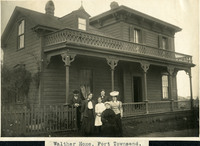 McCarthy Album 08, Photograph 075
McCarthy Album 08, Photograph 075 Caption: "Walther Home, Port Townsend.," c. 1906. William McCarthy (far left) with five unidentified friends in front of a residence in Port Townsend.
-
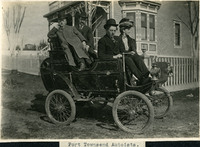 McCarthy Album 08, Photograph 074
McCarthy Album 08, Photograph 074 Caption: "Port Townsend Autoists.," c. 1906. William McCarthy (second from the left) and three unidentified friends in an early, open-roofed automobile.
-
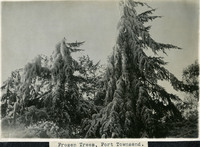 McCarthy Album 08, Photograph 073
McCarthy Album 08, Photograph 073 Caption: "Frozen Trees, Port Townsend," c. 1908-1912. View of icicles weighing down tree branches.
-
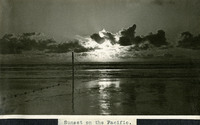 McCarthy Album 08, Photograph 072
McCarthy Album 08, Photograph 072 Caption: "Sunset on the Pacific," c. 1908-1912. Photograph of the sun setting into clouds over the Pacific Ocean, likely near Port Townsend, Washington.
-
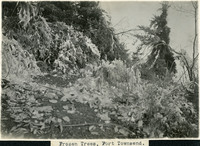 McCarthy Album 08, Photograph 071
McCarthy Album 08, Photograph 071 Caption: "Frozen Trees, Port Townsend," c. 1908-1912. View of icicles and ice shards weighing down tree branches and other vegetation along a path.
-
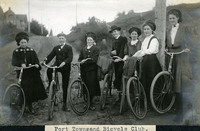 McCarthy Album 08, Photograph 070
McCarthy Album 08, Photograph 070 Caption: "Port Townsend Bicycle Club.," c. 1910. Seven unidentified men and women posing with bicycles. The bicycle made its first appearance in the Puget Sound area in the late 1870s. Within twenty years, thousands of enthusiasts had adapted the new mode of transportation. Such enthusiasts often formed clubs, such as the Queen City Good Roads Club, based in Seattle (south of Port Townsend). These clubs advocated, constructed, and helped to maintain pathways dedicated specifically to bicycle traffic. Ironically, the efforts made by the bicyclists to generally improve roadways contributed to the rise of another new mode of transportation -- the automobile.
-
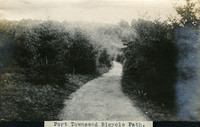 McCarthy Album 08, Photograph 069
McCarthy Album 08, Photograph 069 Caption: "Port Townsend Bicycle Path.," c. 1910. Image of a rural path or road, surrounded by trees and vegetation, with a hill in the distance. The bicycle made its first appearance in the Puget Sound area in the late 1870s. Within twenty years, thousands of enthusiasts had adapted the new mode of transportation. Such enthusiasts often formed clubs, such as the Queen City Good Roads Club, based in Seattle (south of Port Townsend). These clubs advocated, constructed, and helped to maintain pathways dedicated specifically to bicycle traffic. Ironically, the efforts made by the bicyclists to generally improve roadways contributed to the rise of another new mode of transportation -- the automobile.
-
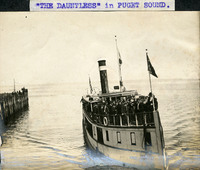 McCarthy Album 08, Photograph 068
McCarthy Album 08, Photograph 068 Caption: "'THE DAUNTLESS' in PUGET SOUND.," c. 1908-1912. View of the Dauntless, a steamship built in 1899. This ship spent most of its career traveling Puget Sound between Port Townsend and Irondale. She was destroyed in a storm in 1923.
-
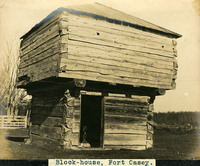 McCarthy Album 08, Photograph 067
McCarthy Album 08, Photograph 067 Caption: "Block-house, Fort Casey.," c. 1908-1912. View of a blockhouse, a timber structure built by European settlers to guard against attack during the Indian Wars of 1855-1857. See also 96-07-08-alb08-019.
-
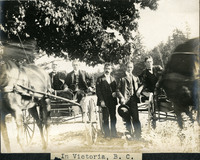 McCarthy Album 08, Photograph 066
McCarthy Album 08, Photograph 066 caption: "In Victoria, B. C.," c. 1906. William McCarthy (standing in the center) and four unidentified men with horse-and-buggies in the Gorge. The Gorge is a narrow tidal inlet in Victoria running from Selkirk Trestle to the Craigflower Bridge. The inlet became a popular recreation destination for the area's residents as Victoria grew.
-
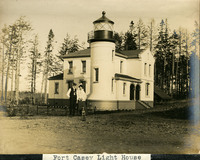 McCarthy Album 08, Photograph 065
McCarthy Album 08, Photograph 065 Caption: "Fort Casey Light House [sic]," c. 1905. Located on Whidbey Island in Puget Sound, the Admiralty Head Lighthouse was built overlooking Admiralty Inlet in 1903. It replaced an earlier structure that had to be moved in 1890 to accommodate the construction of Fort Casey. The second lighthouse, shown here, was built with thick walls in order to withstand earthquakes and the concussion of guns at the fort. The man and woman shown in the photograph (standing with a dog) are likely Charles H. Davis and his second wife Delia (Overton) Davis. Charles Davis was appointed keeper of the lighthouse in 1900 and served until his death in 1914. The lighthouse, deactivated in 1922, has since been restored by Washington State Parks, and is part of the Fort Casey State Park. See also 96-07-08-alb02-057.
-
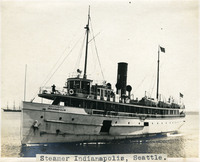 McCarthy Album 08, Photograph 064
McCarthy Album 08, Photograph 064 Caption: "Steamer Indianapolis, Seattle.," c. 1906-1908. View of the Indianapolis, a steamship in the fleet of the Alaskan Steamship Company. Built in 1904, the Indianapolis was purchased by the Alaskan Steamship Company (ASC) in 1906. In 1908, it was transferred to the Puget Sound Navigation Company, a subsidiary to the ASC. The Indianapolis was subsequently scrapped in Seattle, in 1938.
-
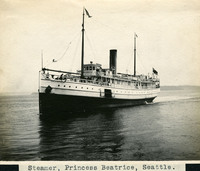 McCarthy Album 08, Photograph 063
McCarthy Album 08, Photograph 063 Caption: "Steamer, Princess Beatrice, Seattle.," c. 1908-1912. View of the Princess Beatrice, a steamship operated by the Canadian Pacific Railway (CPR) between Seattle, Washington, and Victoria, British Columbia. Built in 1903, she made her first trip in January 1904. The CPR operated several ships in the Pacific Northwest, all of which were christened with "Princess" in the name. As a result, the CPR naval fleet was often referred to as "The Pacific Princesses" or the "Princess Fleet."
-
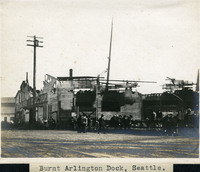 McCarthy Album 08, Photograph 062
McCarthy Album 08, Photograph 062 Caption: "Burnt Arlington Dock, Seattle." This photograph shows the result of a fire at Seattle's Arlington Dock on May 7, 1906. Heavy fire damage can be seen on the building pictured. Its roof and the central portion of the façade collapsed, and burn marks appear at all windows. Thousands of dollars' worth of supplies were destroyed in the fire. At the time, Arlington Dock was the primary shipping facility for the city.
-
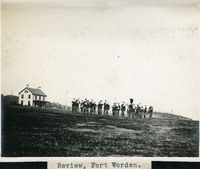 McCarthy Album 08, Photograph 061
McCarthy Album 08, Photograph 061 Caption: "Review, Fort Worden.," c. 1908-1912. Shows a military band playing or preparing to play, with rows of troops assembled in the background on the right side of the photograph. Fort Worden is located in Port Townsend, Washington, on Admiralty Inlet of Puget Sound. Construction began on the fort in 1898, and by 1902 it was serving as an active U.S. Army base. Fort Worden was part of the "triangle of fire," three coastal defense fortifications (Fort Casey, Fort Worden, and Fort Flagler) guarding the entrance to Puget Sound. The U.S. sold the property to the State of Washington in 1957. In 1973, the fort and surrounding area opened as Fort Worden State Park.
-
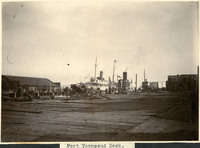 McCarthy Album 08, Photograph 060
McCarthy Album 08, Photograph 060 Caption: "Port Townsend Dock," c. 1908-1912. View of wharf facilities at Port Townsend, including several ships (one of which may be a ferry) and miscellaneous outbuildings.
-
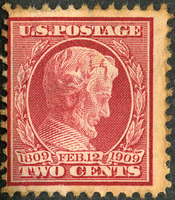 McCarthy Album 08, Photograph 059a
McCarthy Album 08, Photograph 059a No Caption: U.S. two-cent postage stamp issued in 1909 featuring Abraham Lincoln's profile. The stamp marked the centennial of Lincoln's birth on February 12, 1809.
-
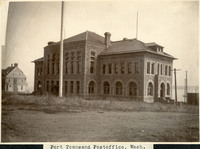 McCarthy Album 08, Photograph 059
McCarthy Album 08, Photograph 059 Caption: "Port Townsend Postoffice [sic], Wash.," c. 1908-1912. View from the rear of the Port Townsend U.S. Customs Office and Post Office. The oldest federally-constructed post office in the state of Washington, the Richardson Romanesque-style building was completed in 1893.
-
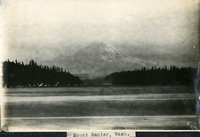 McCarthy Album 08, Photograph 058
McCarthy Album 08, Photograph 058 Caption: "Mount Ranier [sic], Wash.," c. 1908-1912. View of Mount Rainier, the highest peak in the Cascade Range and in the state of Washington, and part of the eastern rim of the Pacific Ring of Fire. Although it is now dormant, it is considered to be a high-risk volcano.
-
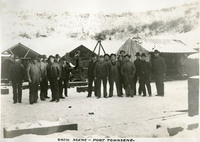 McCarthy Album 08, Photograph 057
McCarthy Album 08, Photograph 057 Caption: "Snow Scene -- Port Townsend.," c. 1908-1912. Group of unidentified men standing in two groups in the snow.
-
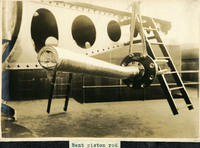 McCarthy Album 08, Photograph 056
McCarthy Album 08, Photograph 056 Caption: "Bent piston rod," c. 1908-1912. View of a damaged piston rod, that appears to be part of a disappearing carriage for a heavy artillery gun, most likely at Fort Flagler.
-
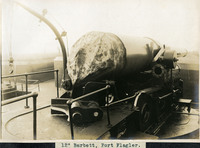 McCarthy Album 08, Photograph 055
McCarthy Album 08, Photograph 055 Caption: "12" Barbett [sic], Fort Flagler.," c. 1908-1912. View of a 12" disappearing gun at Fort Flagler. The coastal artillery fortification Fort Flagler was established in 1897 and activated in 1899. Most of the fort's buildings and batteries had been completed by 1907. Fort Flagler was part of the "triangle of fire," three coastal defense fortifications (Fort Casey, Fort Worden, and Fort Flagler) guarding the entrance to Puget Sound. Fort Flagler was decommissioned in 1953, and purchased by the State of Washington in 1955 for use as a state park.
-
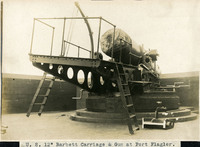 McCarthy Album 08, Photograph 054
McCarthy Album 08, Photograph 054 Caption: "U. S. 12" Barbett [sic] Carriage & Gun at Fort Flagler.," c. 1908-1912. View of a 12" disappearing gun installed at Fort Flagler. The coastal artillery fortification Fort Flagler was established in 1897 and activated in 1899. Most of the fort's buildings and batteries had been completed by 1907. Fort Flagler was part of the "triangle of fire," three coastal defense fortifications (Fort Casey, Fort Worden, and Fort Flagler) guarding the entrance to Puget Sound. Fort Flagler was decommissioned in 1953, and purchased by the State of Washington in 1955 for use as a state park.
-
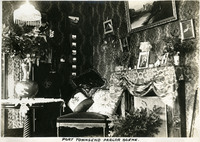 McCarthy Album 08, Photograph 053
McCarthy Album 08, Photograph 053 Caption: "Port Townsend Parlor Scene.," c. 1908-1912. View of a parlor in a Port Townsend residence.
-
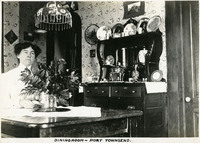 McCarthy Album 08, Photograph 052
McCarthy Album 08, Photograph 052 Caption: "Diningroom [sic] -- Port Townsend.," c. 1908-1912. Grace McCarthy seated at a desk in a parlor or dining room of a residence in Port Townsend.
-
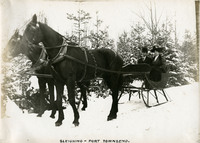 McCarthy Album 08, Photograph 051
McCarthy Album 08, Photograph 051 Caption: "Sleighing -- Port Townsend.," c. 1908-1912. William and Grace McCarthy sitting in a sleigh pulled by two horses, in a snowy landscape.
-
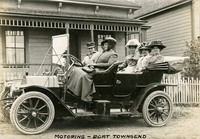 McCarthy Album 08, Photograph 050
McCarthy Album 08, Photograph 050 Caption: "Motoring -- Port Townsend," c. 1908-1912. Grace McCarthy (farthest to the right in backseat) and group of unidentified friends and/or family posing in an automobile in front of a Port Townsend residence.
-
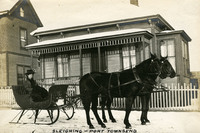 McCarthy Album 08, Photograph 049
McCarthy Album 08, Photograph 049 Caption: "Sleighing -- Port Townsend," c. 1910. Grace McCarthy sitting in horse-drawn sleigh in front of a snow-covered residence in Port Townsend, Washington. See also 96-07-08-alb05-114.
-
 McCarthy Album 08, Photograph 048
McCarthy Album 08, Photograph 048 Caption: "Fort Flagler Beach," c. 1908-1912. This photograph features a dirt track in the foreground, with various buildings in the middle distance and a headlands and body of water, possibly Puget Sound, in the far distance.
-
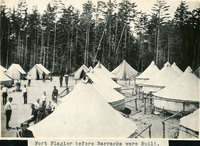 McCarthy Album 08, Photograph 047
McCarthy Album 08, Photograph 047 Caption: "Fort Flagler before Barracks were Built.," c. 1899-1906. The coastal artillery fortification Fort Flagler was established in 1897 and activated in 1899. Most of the fort's buildings and batteries had been completed by 1907. Fort Flagler was part of the "triangle of fire," three coastal defense fortifications (Fort Casey, Fort Worden, and Fort Flagler) guarding the entrance to Puget Sound. Fort Flagler was decommissioned in 1953, and purchased by the State of Washington in 1955 for use as a state park.
-
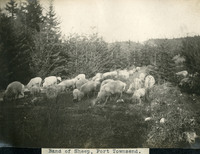 McCarthy Album 08, Photograph 046
McCarthy Album 08, Photograph 046 Caption: "Band of Sheep, Port Townsend.," c. 1908-1912. This photograph shows a herd of sheep grazing in a wooded area near Port Townsend, Washington.
-
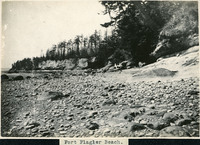 McCarthy Album 08, Photograph 045
McCarthy Album 08, Photograph 045 Caption: "Fort Flagler Beach.," c. 1908-1912. Shows a rocky beach with a small cliff in the distance.
-
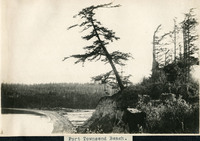 McCarthy Album 08, Photograph 044
McCarthy Album 08, Photograph 044 Caption: "Port Townsend Beach.," c. 1908-1912. Tree on edge of cliff, with beach in the distance.
-
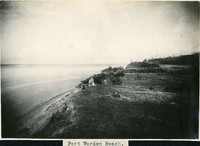 McCarthy Album 08, Photograph 043
McCarthy Album 08, Photograph 043 Caption: "Fort Worden Beach.," c. 1908-1912. Ocean shore scene at Fort Worden, near Port Townsend. Construction began on the fort in 1898, and by 1902 it was serving as an active U.S. Army base. Fort Worden was part of the "triangle of fire," three coastal defense fortifications (Fort Casey, Fort Worden, and Fort Flagler) guarding the entrance to Puget Sound. The U.S. sold the property to the state of Washington in 1957. In 1973, the fort and surrounding area opened as Fort Worden State Park.
-
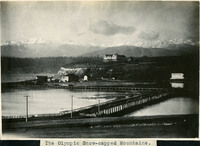 McCarthy Album 08, Photograph 042
McCarthy Album 08, Photograph 042 Caption: "The Olympic Snow-capped Mountains.," c. 1908-1912. View of a coastal inlet or tideland with raised roads, a large building (probably a resort hotel) in the middle distance, and the white-capped Olympic Mountains in the far distance.
-
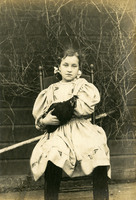 McCarthy Album 08, Photograph 041
McCarthy Album 08, Photograph 041 No Caption: c. 1910. Unidentified young girl posing with chicken, likely somewhere in Washington.
-
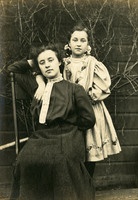 McCarthy Album 08, Photograph 040
McCarthy Album 08, Photograph 040 No Caption: c. 1910. Woman posing with young girl, both of whom are unidentified, likely somewhere in Washington.
-
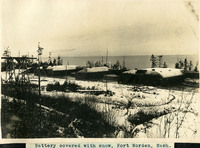 McCarthy Album 08, Photograph 039
McCarthy Album 08, Photograph 039 Caption: "Battery covered with snow, Fort Worden, Wash.," c. 1908-1912. Shows the three batteries at Fort Worden covered in a blanket of snow, with the ocean or Puget Sound in the distance. Construction began on the fort in 1898, and by 1902 it was serving as an active U.S. Army base. Fort Worden was part of the "triangle of fire," three coastal defense fortifications (Fort Casey, Fort Worden, and Fort Flagler) guarding the entrance to Puget Sound. The U.S. sold the property to the state of Washington in 1957. In 1973, the fort and surrounding area opened as Fort Worden State Park.
-
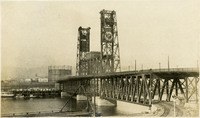 McCarthy Album 08, Photograph 038
McCarthy Album 08, Photograph 038 Caption: "Union Pacific Bridge -- Portland, OR.," c. 1915. Built in 1912, this through-truss, double-decker vertical lift bridge crosses the Willamette River in Portland, Oregon. See also 96-07-08-alb05-182.
-
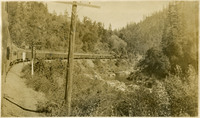 McCarthy Album 08, Photograph 037
McCarthy Album 08, Photograph 037 Caption: "Sacramento River Scene," c. 1910. Train running along Sacramento River in foothills or mountains. See also 96-07-08-alb08-037.
-
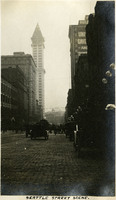 McCarthy Album 08, Photograph 036
McCarthy Album 08, Photograph 036 Caption: "Seattle Street Scene." Street view in Seattle, with Smith Tower in background. See also 96-07-08-alb05-178.
-
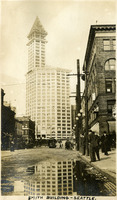 McCarthy Album 08, Photograph 035
McCarthy Album 08, Photograph 035 Caption: "Smith Building -- Seattle." View of the neoclassical Smith Tower in Seattle, built by industrialist Lyman Cornelius Smith. At the time of its completion in 1914, the Smith Tower was the tallest building on the West Coast, until being superseded by the Space Needle in 1962. See also 96-07-08-alb05-177.
-
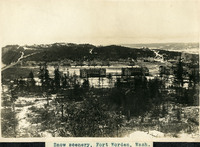 McCarthy Album 08, Photograph 034
McCarthy Album 08, Photograph 034 Caption: "Snow scenery, Fort Worden, Wash.," c. 1908. Overview of Fort Worden in Port Townsend, Washington, on Admiralty Inlet of Puget Sound. Construction began on the fort in 1898. By 1902 it was serving as an active U.S. Army base. Fort Worden was part of the so-called "triangle of fire," three coastal defense fortifications (Fort Casey, Fort Worden, and Fort Flagler) guarding the entrance to Puget Sound. The U.S. sold the property to the State of Washington in 1957. In 1973, the fort and surrounding area opened as Fort Worden State Park.
-
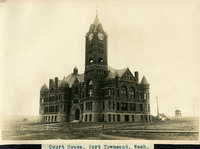 McCarthy Album 08, Photograph 033
McCarthy Album 08, Photograph 033 Caption: "Court House, Port Townsend, Wash.," c. 1908-1912. View of the Jefferson County Courthouse in Port Townsend, Washington. Built the early 1890s and designed by W. A. Ritchie, the Romanesque-style building features a 124-foot clock tower, red bricks from St. Louis, and sandstone from Alaska.
-
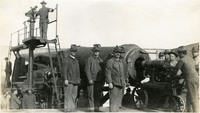 McCarthy Album 08, Photograph 032
McCarthy Album 08, Photograph 032 No Caption: c. 1908-1912. Group of men posing around a 12-inch disappearing gun. Retracting or disappearing guns were a form of artillery developed in the nineteenth century in which heavy artillery guns were placed on rotating carriages that allowed retraction of the weapon after firing, to enable reloading while under enemy fire. Such guns were often used in coastal fortifications.
-
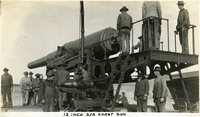 McCarthy Album 08, Photograph 031
McCarthy Album 08, Photograph 031 Caption: "12 Inch Sea Coast Gun," c. 1908-1912. Group of men operating or maintaining a 12-inch disappearing gun. Retracting or disappearing guns were a form of artillery developed in the nineteenth century in which heavy artillery guns were placed on rotating carriages that allowed retraction of the weapon after firing, to enable reloading while under enemy fire. Such guns were often used in coastal fortifications.
-
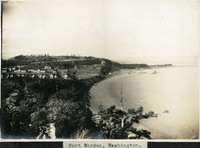 McCarthy Album 08, Photograph 030
McCarthy Album 08, Photograph 030 Caption: "Fort Worden Wash.," c. 1908. Overview of Fort Worden in Port Townsend, Washington, on Admiralty Inlet of Puget Sound. Construction began on the fort in 1898, and by 1902 it was serving as an active U.S. Army base. Fort Worden was part of the "triangle of fire," three coastal defense fortifications (Fort Casey, Fort Worden, and Fort Flagler) guarding the entrance to Puget Sound. The U.S. sold the property to the state of Washington in 1957. In 1973, the fort and surrounding area opened as Fort Worden State Park.
-
 McCarthy Album 08, Photograph 029
McCarthy Album 08, Photograph 029 Caption: "Target Practice," c. 1908. This postcard shows a plume of seawater thrown up by a mortar shell during target practice at Fort Point. The facilities at Fort Point were part of an effort by the U.S. government to protect the Golden Gate, entrance to the San Francisco Bay. Built between 1853-1861, the fort included emplacements for 141 guns but never fired a weapon in defense of the Bay. Its name was officially changed in 1882 to Fort Winfield Scott, but in 1886 the fort was officially downgraded to a sub-post of the San Francisco Presidio and the name discontinued. It was resurrected in 1912, with the establishment of a coastal artillery fortification at the Presidio, called, once again, Fort Winfield Scott. See also 96-07-08-alb05-322.
-
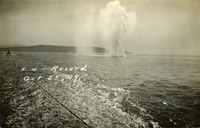 McCarthy Album 08, Photograph 028
McCarthy Album 08, Photograph 028 Caption: "#4 -- Record Oct 25, 09." This postcard shows plume of seawater thrown up by a mortar shell during target practice at Fort Point. The facilities at Fort Point were part of an effort by the U.S. government to protect the Golden Gate, entrance to the San Francisco Bay. Built between 1853-1861, the fort included emplacements for 141 guns but never fired a weapon in defense of the Bay. Its name was officially changed in 1882 to Fort Winfield Scott, but in 1886 the fort was officially downgraded to a sub-post of the San Francisco Presidio and the name discontinued. It was resurrected in 1912, with the establishment of a coastal artillery fortification at the Presidio, called, once again, Fort Winfield Scott.
-
 McCarthy Album 08, Photograph 027
McCarthy Album 08, Photograph 027 Caption: "Main Street, Port Townsend.," c. 1908-1912. Street scene in Washington's Port Townsend, on the tip of the Olympic Peninsula on the shores of Puget Sound.
 McCarthy Album 08, Photograph 075 Caption: "Walther Home, Port Townsend.," c. 1906. William McCarthy (far left) with five unidentified friends in front of a residence in Port Townsend.
McCarthy Album 08, Photograph 075 Caption: "Walther Home, Port Townsend.," c. 1906. William McCarthy (far left) with five unidentified friends in front of a residence in Port Townsend. McCarthy Album 08, Photograph 074 Caption: "Port Townsend Autoists.," c. 1906. William McCarthy (second from the left) and three unidentified friends in an early, open-roofed automobile.
McCarthy Album 08, Photograph 074 Caption: "Port Townsend Autoists.," c. 1906. William McCarthy (second from the left) and three unidentified friends in an early, open-roofed automobile. McCarthy Album 08, Photograph 073 Caption: "Frozen Trees, Port Townsend," c. 1908-1912. View of icicles weighing down tree branches.
McCarthy Album 08, Photograph 073 Caption: "Frozen Trees, Port Townsend," c. 1908-1912. View of icicles weighing down tree branches. McCarthy Album 08, Photograph 072 Caption: "Sunset on the Pacific," c. 1908-1912. Photograph of the sun setting into clouds over the Pacific Ocean, likely near Port Townsend, Washington.
McCarthy Album 08, Photograph 072 Caption: "Sunset on the Pacific," c. 1908-1912. Photograph of the sun setting into clouds over the Pacific Ocean, likely near Port Townsend, Washington. McCarthy Album 08, Photograph 071 Caption: "Frozen Trees, Port Townsend," c. 1908-1912. View of icicles and ice shards weighing down tree branches and other vegetation along a path.
McCarthy Album 08, Photograph 071 Caption: "Frozen Trees, Port Townsend," c. 1908-1912. View of icicles and ice shards weighing down tree branches and other vegetation along a path. McCarthy Album 08, Photograph 070 Caption: "Port Townsend Bicycle Club.," c. 1910. Seven unidentified men and women posing with bicycles. The bicycle made its first appearance in the Puget Sound area in the late 1870s. Within twenty years, thousands of enthusiasts had adapted the new mode of transportation. Such enthusiasts often formed clubs, such as the Queen City Good Roads Club, based in Seattle (south of Port Townsend). These clubs advocated, constructed, and helped to maintain pathways dedicated specifically to bicycle traffic. Ironically, the efforts made by the bicyclists to generally improve roadways contributed to the rise of another new mode of transportation -- the automobile.
McCarthy Album 08, Photograph 070 Caption: "Port Townsend Bicycle Club.," c. 1910. Seven unidentified men and women posing with bicycles. The bicycle made its first appearance in the Puget Sound area in the late 1870s. Within twenty years, thousands of enthusiasts had adapted the new mode of transportation. Such enthusiasts often formed clubs, such as the Queen City Good Roads Club, based in Seattle (south of Port Townsend). These clubs advocated, constructed, and helped to maintain pathways dedicated specifically to bicycle traffic. Ironically, the efforts made by the bicyclists to generally improve roadways contributed to the rise of another new mode of transportation -- the automobile. McCarthy Album 08, Photograph 069 Caption: "Port Townsend Bicycle Path.," c. 1910. Image of a rural path or road, surrounded by trees and vegetation, with a hill in the distance. The bicycle made its first appearance in the Puget Sound area in the late 1870s. Within twenty years, thousands of enthusiasts had adapted the new mode of transportation. Such enthusiasts often formed clubs, such as the Queen City Good Roads Club, based in Seattle (south of Port Townsend). These clubs advocated, constructed, and helped to maintain pathways dedicated specifically to bicycle traffic. Ironically, the efforts made by the bicyclists to generally improve roadways contributed to the rise of another new mode of transportation -- the automobile.
McCarthy Album 08, Photograph 069 Caption: "Port Townsend Bicycle Path.," c. 1910. Image of a rural path or road, surrounded by trees and vegetation, with a hill in the distance. The bicycle made its first appearance in the Puget Sound area in the late 1870s. Within twenty years, thousands of enthusiasts had adapted the new mode of transportation. Such enthusiasts often formed clubs, such as the Queen City Good Roads Club, based in Seattle (south of Port Townsend). These clubs advocated, constructed, and helped to maintain pathways dedicated specifically to bicycle traffic. Ironically, the efforts made by the bicyclists to generally improve roadways contributed to the rise of another new mode of transportation -- the automobile. McCarthy Album 08, Photograph 068 Caption: "'THE DAUNTLESS' in PUGET SOUND.," c. 1908-1912. View of the Dauntless, a steamship built in 1899. This ship spent most of its career traveling Puget Sound between Port Townsend and Irondale. She was destroyed in a storm in 1923.
McCarthy Album 08, Photograph 068 Caption: "'THE DAUNTLESS' in PUGET SOUND.," c. 1908-1912. View of the Dauntless, a steamship built in 1899. This ship spent most of its career traveling Puget Sound between Port Townsend and Irondale. She was destroyed in a storm in 1923. McCarthy Album 08, Photograph 067 Caption: "Block-house, Fort Casey.," c. 1908-1912. View of a blockhouse, a timber structure built by European settlers to guard against attack during the Indian Wars of 1855-1857. See also 96-07-08-alb08-019.
McCarthy Album 08, Photograph 067 Caption: "Block-house, Fort Casey.," c. 1908-1912. View of a blockhouse, a timber structure built by European settlers to guard against attack during the Indian Wars of 1855-1857. See also 96-07-08-alb08-019. McCarthy Album 08, Photograph 066 caption: "In Victoria, B. C.," c. 1906. William McCarthy (standing in the center) and four unidentified men with horse-and-buggies in the Gorge. The Gorge is a narrow tidal inlet in Victoria running from Selkirk Trestle to the Craigflower Bridge. The inlet became a popular recreation destination for the area's residents as Victoria grew.
McCarthy Album 08, Photograph 066 caption: "In Victoria, B. C.," c. 1906. William McCarthy (standing in the center) and four unidentified men with horse-and-buggies in the Gorge. The Gorge is a narrow tidal inlet in Victoria running from Selkirk Trestle to the Craigflower Bridge. The inlet became a popular recreation destination for the area's residents as Victoria grew. McCarthy Album 08, Photograph 065 Caption: "Fort Casey Light House [sic]," c. 1905. Located on Whidbey Island in Puget Sound, the Admiralty Head Lighthouse was built overlooking Admiralty Inlet in 1903. It replaced an earlier structure that had to be moved in 1890 to accommodate the construction of Fort Casey. The second lighthouse, shown here, was built with thick walls in order to withstand earthquakes and the concussion of guns at the fort. The man and woman shown in the photograph (standing with a dog) are likely Charles H. Davis and his second wife Delia (Overton) Davis. Charles Davis was appointed keeper of the lighthouse in 1900 and served until his death in 1914. The lighthouse, deactivated in 1922, has since been restored by Washington State Parks, and is part of the Fort Casey State Park. See also 96-07-08-alb02-057.
McCarthy Album 08, Photograph 065 Caption: "Fort Casey Light House [sic]," c. 1905. Located on Whidbey Island in Puget Sound, the Admiralty Head Lighthouse was built overlooking Admiralty Inlet in 1903. It replaced an earlier structure that had to be moved in 1890 to accommodate the construction of Fort Casey. The second lighthouse, shown here, was built with thick walls in order to withstand earthquakes and the concussion of guns at the fort. The man and woman shown in the photograph (standing with a dog) are likely Charles H. Davis and his second wife Delia (Overton) Davis. Charles Davis was appointed keeper of the lighthouse in 1900 and served until his death in 1914. The lighthouse, deactivated in 1922, has since been restored by Washington State Parks, and is part of the Fort Casey State Park. See also 96-07-08-alb02-057. McCarthy Album 08, Photograph 064 Caption: "Steamer Indianapolis, Seattle.," c. 1906-1908. View of the Indianapolis, a steamship in the fleet of the Alaskan Steamship Company. Built in 1904, the Indianapolis was purchased by the Alaskan Steamship Company (ASC) in 1906. In 1908, it was transferred to the Puget Sound Navigation Company, a subsidiary to the ASC. The Indianapolis was subsequently scrapped in Seattle, in 1938.
McCarthy Album 08, Photograph 064 Caption: "Steamer Indianapolis, Seattle.," c. 1906-1908. View of the Indianapolis, a steamship in the fleet of the Alaskan Steamship Company. Built in 1904, the Indianapolis was purchased by the Alaskan Steamship Company (ASC) in 1906. In 1908, it was transferred to the Puget Sound Navigation Company, a subsidiary to the ASC. The Indianapolis was subsequently scrapped in Seattle, in 1938. McCarthy Album 08, Photograph 063 Caption: "Steamer, Princess Beatrice, Seattle.," c. 1908-1912. View of the Princess Beatrice, a steamship operated by the Canadian Pacific Railway (CPR) between Seattle, Washington, and Victoria, British Columbia. Built in 1903, she made her first trip in January 1904. The CPR operated several ships in the Pacific Northwest, all of which were christened with "Princess" in the name. As a result, the CPR naval fleet was often referred to as "The Pacific Princesses" or the "Princess Fleet."
McCarthy Album 08, Photograph 063 Caption: "Steamer, Princess Beatrice, Seattle.," c. 1908-1912. View of the Princess Beatrice, a steamship operated by the Canadian Pacific Railway (CPR) between Seattle, Washington, and Victoria, British Columbia. Built in 1903, she made her first trip in January 1904. The CPR operated several ships in the Pacific Northwest, all of which were christened with "Princess" in the name. As a result, the CPR naval fleet was often referred to as "The Pacific Princesses" or the "Princess Fleet." McCarthy Album 08, Photograph 062 Caption: "Burnt Arlington Dock, Seattle." This photograph shows the result of a fire at Seattle's Arlington Dock on May 7, 1906. Heavy fire damage can be seen on the building pictured. Its roof and the central portion of the façade collapsed, and burn marks appear at all windows. Thousands of dollars' worth of supplies were destroyed in the fire. At the time, Arlington Dock was the primary shipping facility for the city.
McCarthy Album 08, Photograph 062 Caption: "Burnt Arlington Dock, Seattle." This photograph shows the result of a fire at Seattle's Arlington Dock on May 7, 1906. Heavy fire damage can be seen on the building pictured. Its roof and the central portion of the façade collapsed, and burn marks appear at all windows. Thousands of dollars' worth of supplies were destroyed in the fire. At the time, Arlington Dock was the primary shipping facility for the city. McCarthy Album 08, Photograph 061 Caption: "Review, Fort Worden.," c. 1908-1912. Shows a military band playing or preparing to play, with rows of troops assembled in the background on the right side of the photograph. Fort Worden is located in Port Townsend, Washington, on Admiralty Inlet of Puget Sound. Construction began on the fort in 1898, and by 1902 it was serving as an active U.S. Army base. Fort Worden was part of the "triangle of fire," three coastal defense fortifications (Fort Casey, Fort Worden, and Fort Flagler) guarding the entrance to Puget Sound. The U.S. sold the property to the State of Washington in 1957. In 1973, the fort and surrounding area opened as Fort Worden State Park.
McCarthy Album 08, Photograph 061 Caption: "Review, Fort Worden.," c. 1908-1912. Shows a military band playing or preparing to play, with rows of troops assembled in the background on the right side of the photograph. Fort Worden is located in Port Townsend, Washington, on Admiralty Inlet of Puget Sound. Construction began on the fort in 1898, and by 1902 it was serving as an active U.S. Army base. Fort Worden was part of the "triangle of fire," three coastal defense fortifications (Fort Casey, Fort Worden, and Fort Flagler) guarding the entrance to Puget Sound. The U.S. sold the property to the State of Washington in 1957. In 1973, the fort and surrounding area opened as Fort Worden State Park. McCarthy Album 08, Photograph 060 Caption: "Port Townsend Dock," c. 1908-1912. View of wharf facilities at Port Townsend, including several ships (one of which may be a ferry) and miscellaneous outbuildings.
McCarthy Album 08, Photograph 060 Caption: "Port Townsend Dock," c. 1908-1912. View of wharf facilities at Port Townsend, including several ships (one of which may be a ferry) and miscellaneous outbuildings. McCarthy Album 08, Photograph 059a No Caption: U.S. two-cent postage stamp issued in 1909 featuring Abraham Lincoln's profile. The stamp marked the centennial of Lincoln's birth on February 12, 1809.
McCarthy Album 08, Photograph 059a No Caption: U.S. two-cent postage stamp issued in 1909 featuring Abraham Lincoln's profile. The stamp marked the centennial of Lincoln's birth on February 12, 1809. McCarthy Album 08, Photograph 059 Caption: "Port Townsend Postoffice [sic], Wash.," c. 1908-1912. View from the rear of the Port Townsend U.S. Customs Office and Post Office. The oldest federally-constructed post office in the state of Washington, the Richardson Romanesque-style building was completed in 1893.
McCarthy Album 08, Photograph 059 Caption: "Port Townsend Postoffice [sic], Wash.," c. 1908-1912. View from the rear of the Port Townsend U.S. Customs Office and Post Office. The oldest federally-constructed post office in the state of Washington, the Richardson Romanesque-style building was completed in 1893. McCarthy Album 08, Photograph 058 Caption: "Mount Ranier [sic], Wash.," c. 1908-1912. View of Mount Rainier, the highest peak in the Cascade Range and in the state of Washington, and part of the eastern rim of the Pacific Ring of Fire. Although it is now dormant, it is considered to be a high-risk volcano.
McCarthy Album 08, Photograph 058 Caption: "Mount Ranier [sic], Wash.," c. 1908-1912. View of Mount Rainier, the highest peak in the Cascade Range and in the state of Washington, and part of the eastern rim of the Pacific Ring of Fire. Although it is now dormant, it is considered to be a high-risk volcano. McCarthy Album 08, Photograph 057 Caption: "Snow Scene -- Port Townsend.," c. 1908-1912. Group of unidentified men standing in two groups in the snow.
McCarthy Album 08, Photograph 057 Caption: "Snow Scene -- Port Townsend.," c. 1908-1912. Group of unidentified men standing in two groups in the snow. McCarthy Album 08, Photograph 056 Caption: "Bent piston rod," c. 1908-1912. View of a damaged piston rod, that appears to be part of a disappearing carriage for a heavy artillery gun, most likely at Fort Flagler.
McCarthy Album 08, Photograph 056 Caption: "Bent piston rod," c. 1908-1912. View of a damaged piston rod, that appears to be part of a disappearing carriage for a heavy artillery gun, most likely at Fort Flagler. McCarthy Album 08, Photograph 055 Caption: "12" Barbett [sic], Fort Flagler.," c. 1908-1912. View of a 12" disappearing gun at Fort Flagler. The coastal artillery fortification Fort Flagler was established in 1897 and activated in 1899. Most of the fort's buildings and batteries had been completed by 1907. Fort Flagler was part of the "triangle of fire," three coastal defense fortifications (Fort Casey, Fort Worden, and Fort Flagler) guarding the entrance to Puget Sound. Fort Flagler was decommissioned in 1953, and purchased by the State of Washington in 1955 for use as a state park.
McCarthy Album 08, Photograph 055 Caption: "12" Barbett [sic], Fort Flagler.," c. 1908-1912. View of a 12" disappearing gun at Fort Flagler. The coastal artillery fortification Fort Flagler was established in 1897 and activated in 1899. Most of the fort's buildings and batteries had been completed by 1907. Fort Flagler was part of the "triangle of fire," three coastal defense fortifications (Fort Casey, Fort Worden, and Fort Flagler) guarding the entrance to Puget Sound. Fort Flagler was decommissioned in 1953, and purchased by the State of Washington in 1955 for use as a state park. McCarthy Album 08, Photograph 054 Caption: "U. S. 12" Barbett [sic] Carriage & Gun at Fort Flagler.," c. 1908-1912. View of a 12" disappearing gun installed at Fort Flagler. The coastal artillery fortification Fort Flagler was established in 1897 and activated in 1899. Most of the fort's buildings and batteries had been completed by 1907. Fort Flagler was part of the "triangle of fire," three coastal defense fortifications (Fort Casey, Fort Worden, and Fort Flagler) guarding the entrance to Puget Sound. Fort Flagler was decommissioned in 1953, and purchased by the State of Washington in 1955 for use as a state park.
McCarthy Album 08, Photograph 054 Caption: "U. S. 12" Barbett [sic] Carriage & Gun at Fort Flagler.," c. 1908-1912. View of a 12" disappearing gun installed at Fort Flagler. The coastal artillery fortification Fort Flagler was established in 1897 and activated in 1899. Most of the fort's buildings and batteries had been completed by 1907. Fort Flagler was part of the "triangle of fire," three coastal defense fortifications (Fort Casey, Fort Worden, and Fort Flagler) guarding the entrance to Puget Sound. Fort Flagler was decommissioned in 1953, and purchased by the State of Washington in 1955 for use as a state park. McCarthy Album 08, Photograph 053 Caption: "Port Townsend Parlor Scene.," c. 1908-1912. View of a parlor in a Port Townsend residence.
McCarthy Album 08, Photograph 053 Caption: "Port Townsend Parlor Scene.," c. 1908-1912. View of a parlor in a Port Townsend residence. McCarthy Album 08, Photograph 052 Caption: "Diningroom [sic] -- Port Townsend.," c. 1908-1912. Grace McCarthy seated at a desk in a parlor or dining room of a residence in Port Townsend.
McCarthy Album 08, Photograph 052 Caption: "Diningroom [sic] -- Port Townsend.," c. 1908-1912. Grace McCarthy seated at a desk in a parlor or dining room of a residence in Port Townsend. McCarthy Album 08, Photograph 051 Caption: "Sleighing -- Port Townsend.," c. 1908-1912. William and Grace McCarthy sitting in a sleigh pulled by two horses, in a snowy landscape.
McCarthy Album 08, Photograph 051 Caption: "Sleighing -- Port Townsend.," c. 1908-1912. William and Grace McCarthy sitting in a sleigh pulled by two horses, in a snowy landscape. McCarthy Album 08, Photograph 050 Caption: "Motoring -- Port Townsend," c. 1908-1912. Grace McCarthy (farthest to the right in backseat) and group of unidentified friends and/or family posing in an automobile in front of a Port Townsend residence.
McCarthy Album 08, Photograph 050 Caption: "Motoring -- Port Townsend," c. 1908-1912. Grace McCarthy (farthest to the right in backseat) and group of unidentified friends and/or family posing in an automobile in front of a Port Townsend residence. McCarthy Album 08, Photograph 049 Caption: "Sleighing -- Port Townsend," c. 1910. Grace McCarthy sitting in horse-drawn sleigh in front of a snow-covered residence in Port Townsend, Washington. See also 96-07-08-alb05-114.
McCarthy Album 08, Photograph 049 Caption: "Sleighing -- Port Townsend," c. 1910. Grace McCarthy sitting in horse-drawn sleigh in front of a snow-covered residence in Port Townsend, Washington. See also 96-07-08-alb05-114. McCarthy Album 08, Photograph 048 Caption: "Fort Flagler Beach," c. 1908-1912. This photograph features a dirt track in the foreground, with various buildings in the middle distance and a headlands and body of water, possibly Puget Sound, in the far distance.
McCarthy Album 08, Photograph 048 Caption: "Fort Flagler Beach," c. 1908-1912. This photograph features a dirt track in the foreground, with various buildings in the middle distance and a headlands and body of water, possibly Puget Sound, in the far distance. McCarthy Album 08, Photograph 047 Caption: "Fort Flagler before Barracks were Built.," c. 1899-1906. The coastal artillery fortification Fort Flagler was established in 1897 and activated in 1899. Most of the fort's buildings and batteries had been completed by 1907. Fort Flagler was part of the "triangle of fire," three coastal defense fortifications (Fort Casey, Fort Worden, and Fort Flagler) guarding the entrance to Puget Sound. Fort Flagler was decommissioned in 1953, and purchased by the State of Washington in 1955 for use as a state park.
McCarthy Album 08, Photograph 047 Caption: "Fort Flagler before Barracks were Built.," c. 1899-1906. The coastal artillery fortification Fort Flagler was established in 1897 and activated in 1899. Most of the fort's buildings and batteries had been completed by 1907. Fort Flagler was part of the "triangle of fire," three coastal defense fortifications (Fort Casey, Fort Worden, and Fort Flagler) guarding the entrance to Puget Sound. Fort Flagler was decommissioned in 1953, and purchased by the State of Washington in 1955 for use as a state park. McCarthy Album 08, Photograph 046 Caption: "Band of Sheep, Port Townsend.," c. 1908-1912. This photograph shows a herd of sheep grazing in a wooded area near Port Townsend, Washington.
McCarthy Album 08, Photograph 046 Caption: "Band of Sheep, Port Townsend.," c. 1908-1912. This photograph shows a herd of sheep grazing in a wooded area near Port Townsend, Washington. McCarthy Album 08, Photograph 045 Caption: "Fort Flagler Beach.," c. 1908-1912. Shows a rocky beach with a small cliff in the distance.
McCarthy Album 08, Photograph 045 Caption: "Fort Flagler Beach.," c. 1908-1912. Shows a rocky beach with a small cliff in the distance. McCarthy Album 08, Photograph 044 Caption: "Port Townsend Beach.," c. 1908-1912. Tree on edge of cliff, with beach in the distance.
McCarthy Album 08, Photograph 044 Caption: "Port Townsend Beach.," c. 1908-1912. Tree on edge of cliff, with beach in the distance. McCarthy Album 08, Photograph 043 Caption: "Fort Worden Beach.," c. 1908-1912. Ocean shore scene at Fort Worden, near Port Townsend. Construction began on the fort in 1898, and by 1902 it was serving as an active U.S. Army base. Fort Worden was part of the "triangle of fire," three coastal defense fortifications (Fort Casey, Fort Worden, and Fort Flagler) guarding the entrance to Puget Sound. The U.S. sold the property to the state of Washington in 1957. In 1973, the fort and surrounding area opened as Fort Worden State Park.
McCarthy Album 08, Photograph 043 Caption: "Fort Worden Beach.," c. 1908-1912. Ocean shore scene at Fort Worden, near Port Townsend. Construction began on the fort in 1898, and by 1902 it was serving as an active U.S. Army base. Fort Worden was part of the "triangle of fire," three coastal defense fortifications (Fort Casey, Fort Worden, and Fort Flagler) guarding the entrance to Puget Sound. The U.S. sold the property to the state of Washington in 1957. In 1973, the fort and surrounding area opened as Fort Worden State Park. McCarthy Album 08, Photograph 042 Caption: "The Olympic Snow-capped Mountains.," c. 1908-1912. View of a coastal inlet or tideland with raised roads, a large building (probably a resort hotel) in the middle distance, and the white-capped Olympic Mountains in the far distance.
McCarthy Album 08, Photograph 042 Caption: "The Olympic Snow-capped Mountains.," c. 1908-1912. View of a coastal inlet or tideland with raised roads, a large building (probably a resort hotel) in the middle distance, and the white-capped Olympic Mountains in the far distance. McCarthy Album 08, Photograph 041 No Caption: c. 1910. Unidentified young girl posing with chicken, likely somewhere in Washington.
McCarthy Album 08, Photograph 041 No Caption: c. 1910. Unidentified young girl posing with chicken, likely somewhere in Washington. McCarthy Album 08, Photograph 040 No Caption: c. 1910. Woman posing with young girl, both of whom are unidentified, likely somewhere in Washington.
McCarthy Album 08, Photograph 040 No Caption: c. 1910. Woman posing with young girl, both of whom are unidentified, likely somewhere in Washington. McCarthy Album 08, Photograph 039 Caption: "Battery covered with snow, Fort Worden, Wash.," c. 1908-1912. Shows the three batteries at Fort Worden covered in a blanket of snow, with the ocean or Puget Sound in the distance. Construction began on the fort in 1898, and by 1902 it was serving as an active U.S. Army base. Fort Worden was part of the "triangle of fire," three coastal defense fortifications (Fort Casey, Fort Worden, and Fort Flagler) guarding the entrance to Puget Sound. The U.S. sold the property to the state of Washington in 1957. In 1973, the fort and surrounding area opened as Fort Worden State Park.
McCarthy Album 08, Photograph 039 Caption: "Battery covered with snow, Fort Worden, Wash.," c. 1908-1912. Shows the three batteries at Fort Worden covered in a blanket of snow, with the ocean or Puget Sound in the distance. Construction began on the fort in 1898, and by 1902 it was serving as an active U.S. Army base. Fort Worden was part of the "triangle of fire," three coastal defense fortifications (Fort Casey, Fort Worden, and Fort Flagler) guarding the entrance to Puget Sound. The U.S. sold the property to the state of Washington in 1957. In 1973, the fort and surrounding area opened as Fort Worden State Park. McCarthy Album 08, Photograph 038 Caption: "Union Pacific Bridge -- Portland, OR.," c. 1915. Built in 1912, this through-truss, double-decker vertical lift bridge crosses the Willamette River in Portland, Oregon. See also 96-07-08-alb05-182.
McCarthy Album 08, Photograph 038 Caption: "Union Pacific Bridge -- Portland, OR.," c. 1915. Built in 1912, this through-truss, double-decker vertical lift bridge crosses the Willamette River in Portland, Oregon. See also 96-07-08-alb05-182. McCarthy Album 08, Photograph 037 Caption: "Sacramento River Scene," c. 1910. Train running along Sacramento River in foothills or mountains. See also 96-07-08-alb08-037.
McCarthy Album 08, Photograph 037 Caption: "Sacramento River Scene," c. 1910. Train running along Sacramento River in foothills or mountains. See also 96-07-08-alb08-037. McCarthy Album 08, Photograph 036 Caption: "Seattle Street Scene." Street view in Seattle, with Smith Tower in background. See also 96-07-08-alb05-178.
McCarthy Album 08, Photograph 036 Caption: "Seattle Street Scene." Street view in Seattle, with Smith Tower in background. See also 96-07-08-alb05-178. McCarthy Album 08, Photograph 035 Caption: "Smith Building -- Seattle." View of the neoclassical Smith Tower in Seattle, built by industrialist Lyman Cornelius Smith. At the time of its completion in 1914, the Smith Tower was the tallest building on the West Coast, until being superseded by the Space Needle in 1962. See also 96-07-08-alb05-177.
McCarthy Album 08, Photograph 035 Caption: "Smith Building -- Seattle." View of the neoclassical Smith Tower in Seattle, built by industrialist Lyman Cornelius Smith. At the time of its completion in 1914, the Smith Tower was the tallest building on the West Coast, until being superseded by the Space Needle in 1962. See also 96-07-08-alb05-177. McCarthy Album 08, Photograph 034 Caption: "Snow scenery, Fort Worden, Wash.," c. 1908. Overview of Fort Worden in Port Townsend, Washington, on Admiralty Inlet of Puget Sound. Construction began on the fort in 1898. By 1902 it was serving as an active U.S. Army base. Fort Worden was part of the so-called "triangle of fire," three coastal defense fortifications (Fort Casey, Fort Worden, and Fort Flagler) guarding the entrance to Puget Sound. The U.S. sold the property to the State of Washington in 1957. In 1973, the fort and surrounding area opened as Fort Worden State Park.
McCarthy Album 08, Photograph 034 Caption: "Snow scenery, Fort Worden, Wash.," c. 1908. Overview of Fort Worden in Port Townsend, Washington, on Admiralty Inlet of Puget Sound. Construction began on the fort in 1898. By 1902 it was serving as an active U.S. Army base. Fort Worden was part of the so-called "triangle of fire," three coastal defense fortifications (Fort Casey, Fort Worden, and Fort Flagler) guarding the entrance to Puget Sound. The U.S. sold the property to the State of Washington in 1957. In 1973, the fort and surrounding area opened as Fort Worden State Park. McCarthy Album 08, Photograph 033 Caption: "Court House, Port Townsend, Wash.," c. 1908-1912. View of the Jefferson County Courthouse in Port Townsend, Washington. Built the early 1890s and designed by W. A. Ritchie, the Romanesque-style building features a 124-foot clock tower, red bricks from St. Louis, and sandstone from Alaska.
McCarthy Album 08, Photograph 033 Caption: "Court House, Port Townsend, Wash.," c. 1908-1912. View of the Jefferson County Courthouse in Port Townsend, Washington. Built the early 1890s and designed by W. A. Ritchie, the Romanesque-style building features a 124-foot clock tower, red bricks from St. Louis, and sandstone from Alaska. McCarthy Album 08, Photograph 032 No Caption: c. 1908-1912. Group of men posing around a 12-inch disappearing gun. Retracting or disappearing guns were a form of artillery developed in the nineteenth century in which heavy artillery guns were placed on rotating carriages that allowed retraction of the weapon after firing, to enable reloading while under enemy fire. Such guns were often used in coastal fortifications.
McCarthy Album 08, Photograph 032 No Caption: c. 1908-1912. Group of men posing around a 12-inch disappearing gun. Retracting or disappearing guns were a form of artillery developed in the nineteenth century in which heavy artillery guns were placed on rotating carriages that allowed retraction of the weapon after firing, to enable reloading while under enemy fire. Such guns were often used in coastal fortifications. McCarthy Album 08, Photograph 031 Caption: "12 Inch Sea Coast Gun," c. 1908-1912. Group of men operating or maintaining a 12-inch disappearing gun. Retracting or disappearing guns were a form of artillery developed in the nineteenth century in which heavy artillery guns were placed on rotating carriages that allowed retraction of the weapon after firing, to enable reloading while under enemy fire. Such guns were often used in coastal fortifications.
McCarthy Album 08, Photograph 031 Caption: "12 Inch Sea Coast Gun," c. 1908-1912. Group of men operating or maintaining a 12-inch disappearing gun. Retracting or disappearing guns were a form of artillery developed in the nineteenth century in which heavy artillery guns were placed on rotating carriages that allowed retraction of the weapon after firing, to enable reloading while under enemy fire. Such guns were often used in coastal fortifications. McCarthy Album 08, Photograph 030 Caption: "Fort Worden Wash.," c. 1908. Overview of Fort Worden in Port Townsend, Washington, on Admiralty Inlet of Puget Sound. Construction began on the fort in 1898, and by 1902 it was serving as an active U.S. Army base. Fort Worden was part of the "triangle of fire," three coastal defense fortifications (Fort Casey, Fort Worden, and Fort Flagler) guarding the entrance to Puget Sound. The U.S. sold the property to the state of Washington in 1957. In 1973, the fort and surrounding area opened as Fort Worden State Park.
McCarthy Album 08, Photograph 030 Caption: "Fort Worden Wash.," c. 1908. Overview of Fort Worden in Port Townsend, Washington, on Admiralty Inlet of Puget Sound. Construction began on the fort in 1898, and by 1902 it was serving as an active U.S. Army base. Fort Worden was part of the "triangle of fire," three coastal defense fortifications (Fort Casey, Fort Worden, and Fort Flagler) guarding the entrance to Puget Sound. The U.S. sold the property to the state of Washington in 1957. In 1973, the fort and surrounding area opened as Fort Worden State Park. McCarthy Album 08, Photograph 029 Caption: "Target Practice," c. 1908. This postcard shows a plume of seawater thrown up by a mortar shell during target practice at Fort Point. The facilities at Fort Point were part of an effort by the U.S. government to protect the Golden Gate, entrance to the San Francisco Bay. Built between 1853-1861, the fort included emplacements for 141 guns but never fired a weapon in defense of the Bay. Its name was officially changed in 1882 to Fort Winfield Scott, but in 1886 the fort was officially downgraded to a sub-post of the San Francisco Presidio and the name discontinued. It was resurrected in 1912, with the establishment of a coastal artillery fortification at the Presidio, called, once again, Fort Winfield Scott. See also 96-07-08-alb05-322.
McCarthy Album 08, Photograph 029 Caption: "Target Practice," c. 1908. This postcard shows a plume of seawater thrown up by a mortar shell during target practice at Fort Point. The facilities at Fort Point were part of an effort by the U.S. government to protect the Golden Gate, entrance to the San Francisco Bay. Built between 1853-1861, the fort included emplacements for 141 guns but never fired a weapon in defense of the Bay. Its name was officially changed in 1882 to Fort Winfield Scott, but in 1886 the fort was officially downgraded to a sub-post of the San Francisco Presidio and the name discontinued. It was resurrected in 1912, with the establishment of a coastal artillery fortification at the Presidio, called, once again, Fort Winfield Scott. See also 96-07-08-alb05-322. McCarthy Album 08, Photograph 028 Caption: "#4 -- Record Oct 25, 09." This postcard shows plume of seawater thrown up by a mortar shell during target practice at Fort Point. The facilities at Fort Point were part of an effort by the U.S. government to protect the Golden Gate, entrance to the San Francisco Bay. Built between 1853-1861, the fort included emplacements for 141 guns but never fired a weapon in defense of the Bay. Its name was officially changed in 1882 to Fort Winfield Scott, but in 1886 the fort was officially downgraded to a sub-post of the San Francisco Presidio and the name discontinued. It was resurrected in 1912, with the establishment of a coastal artillery fortification at the Presidio, called, once again, Fort Winfield Scott.
McCarthy Album 08, Photograph 028 Caption: "#4 -- Record Oct 25, 09." This postcard shows plume of seawater thrown up by a mortar shell during target practice at Fort Point. The facilities at Fort Point were part of an effort by the U.S. government to protect the Golden Gate, entrance to the San Francisco Bay. Built between 1853-1861, the fort included emplacements for 141 guns but never fired a weapon in defense of the Bay. Its name was officially changed in 1882 to Fort Winfield Scott, but in 1886 the fort was officially downgraded to a sub-post of the San Francisco Presidio and the name discontinued. It was resurrected in 1912, with the establishment of a coastal artillery fortification at the Presidio, called, once again, Fort Winfield Scott. McCarthy Album 08, Photograph 027 Caption: "Main Street, Port Townsend.," c. 1908-1912. Street scene in Washington's Port Townsend, on the tip of the Olympic Peninsula on the shores of Puget Sound.
McCarthy Album 08, Photograph 027 Caption: "Main Street, Port Townsend.," c. 1908-1912. Street scene in Washington's Port Townsend, on the tip of the Olympic Peninsula on the shores of Puget Sound.